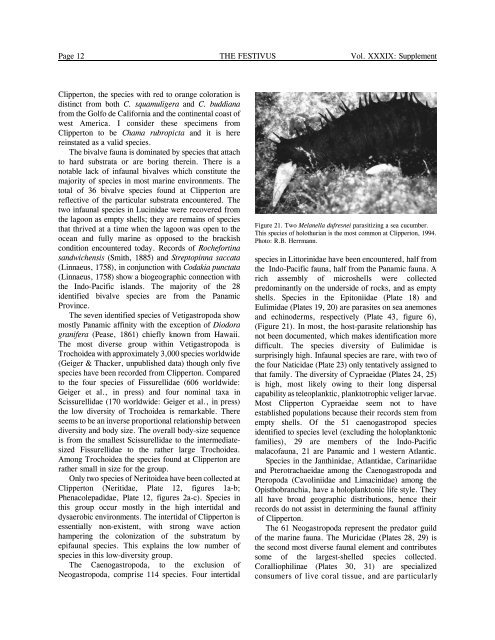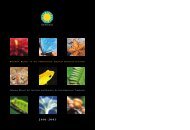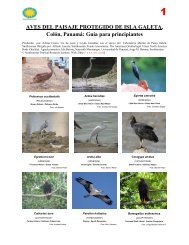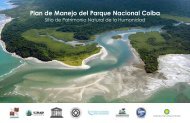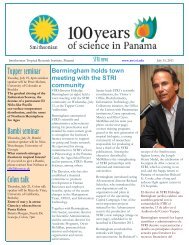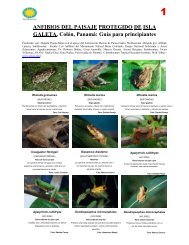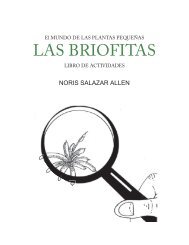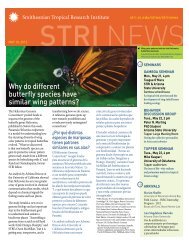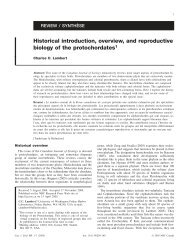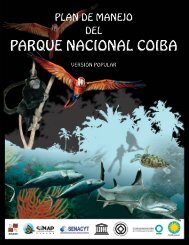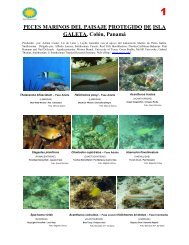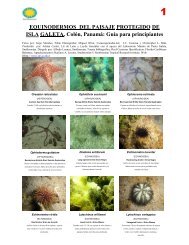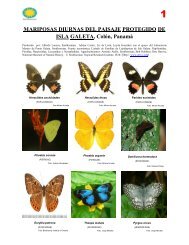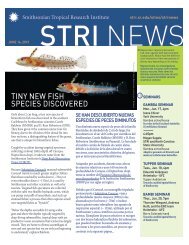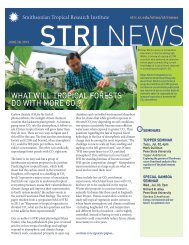Download - Smithsonian Tropical Research Institute - Smithsonian ...
Download - Smithsonian Tropical Research Institute - Smithsonian ...
Download - Smithsonian Tropical Research Institute - Smithsonian ...
Create successful ePaper yourself
Turn your PDF publications into a flip-book with our unique Google optimized e-Paper software.
Page 12 THE FESTIVUS Vol. XXXIX: Supplement<br />
Clipperton, the species with red to orange coloration is<br />
distinct from both C. squamuligera and C. buddiana<br />
from the Golfo de California and the continental coast of<br />
west America. I consider these specimens from<br />
Clipperton to be Chama rubropicta and it is here<br />
reinstated as a valid species.<br />
The bivalve fauna is dominated by species that attach<br />
to hard substrata or are boring therein. There is a<br />
notable lack of infaunal bivalves which constitute the<br />
majority of species in most marine environments. The<br />
total of 36 bivalve species found at Clipperton are<br />
reflective of the particular substrata encountered. The<br />
two infaunal species in Lucinidae were recovered from<br />
the lagoon as empty shells; they are remains of species<br />
that thrived at a time when the lagoon was open to the<br />
ocean and fully marine as opposed to the brackish<br />
condition encountered today. Records of Rochefortina<br />
sandwichensis (Smith, 1885) and Streptopinna saccata<br />
(Linnaeus, 1758), in conjunction with Codakia punctata<br />
(Linnaeus, 1758) show a biogeographic connection with<br />
the Indo-Pacific islands. The majority of the 28<br />
identified bivalve species are from the Panamic<br />
Province.<br />
The seven identified species of Vetigastropoda show<br />
mostly Panamic affinity with the exception of Diodora<br />
granifera (Pease, 1861) chiefly known from Hawaii.<br />
The most diverse group within Vetigastropoda is<br />
Trochoidea with approximately 3,000 species worldwide<br />
(Geiger & Thacker, unpublished data) though only five<br />
species have been recorded from Clipperton. Compared<br />
to the four species of Fissurellidae (606 worldwide:<br />
Geiger et al., in press) and four nominal taxa in<br />
Scissurellidae (170 worldwide: Geiger et al., in press)<br />
the low diversity of Trochoidea is remarkable. There<br />
seems to be an inverse proportional relationship between<br />
diversity and body size. The overall body-size sequence<br />
is from the smallest Scissurellidae to the intermediatesized<br />
Fissurellidae to the rather large Trochoidea.<br />
Among Trochoidea the species found at Clipperton are<br />
rather small in size for the group.<br />
Only two species of Neritoidea have been collected at<br />
Clipperton (Neritidae, Plate 12, figures 1a-b;<br />
Phenacolepadidae, Plate 12, figures 2a-c). Species in<br />
this group occur mostly in the high intertidal and<br />
dysaerobic environments. The intertidal of Clipperton is<br />
essentially non-existent, with strong wave action<br />
hampering the colonization of the substratum by<br />
epifaunal species. This explains the low number of<br />
species in this low-diversity group.<br />
The Caenogastropoda, to the exclusion of<br />
Neogastropoda, comprise 114 species. Four intertidal<br />
Figure 21. Two Melanella dufresnei parasitizing a sea cucumber.<br />
This species of holothurian is the most common at Clipperton, 1994.<br />
Photo: R.B. Herrmann.<br />
species in Littorinidae have been encountered, half from<br />
the Indo-Pacific fauna, half from the Panamic fauna. A<br />
rich assembly of microshells were collected<br />
predominantly on the underside of rocks, and as empty<br />
shells. Species in the Epitoniidae (Plate 18) and<br />
Eulimidae (Plates 19, 20) are parasites on sea anemones<br />
and echinoderms, respectively (Plate 43, figure 6),<br />
(Figure 21). In most, the host-parasite relationship has<br />
not been documented, which makes identification more<br />
difficult. The species diversity of Eulimidae is<br />
surprisingly high. Infaunal species are rare, with two of<br />
the four Naticidae (Plate 23) only tentatively assigned to<br />
that family. The diversity of Cypraeidae (Plates 24, 25)<br />
is high, most likely owing to their long dispersal<br />
capability as teleoplanktic, planktotrophic veliger larvae.<br />
Most Clipperton Cypraeidae seem not to have<br />
established populations because their records stem from<br />
empty shells. Of the 51 caenogastropod species<br />
identified to species level (excluding the holoplanktonic<br />
families), 29 are members of the Indo-Pacific<br />
malacofauna, 21 are Panamic and 1 western Atlantic.<br />
Species in the Janthinidae, Atlantidae, Carinariidae<br />
and Pterotrachaeidae among the Caenogastropoda and<br />
Pteropoda (Cavoliniidae and Limacinidae) among the<br />
Opisthobranchia, have a holoplanktonic life style. They<br />
all have broad geographic distributions, hence their<br />
records do not assist in determining the faunal affinity<br />
of Clipperton.<br />
The 61 Neogastropoda represent the predator guild<br />
of the marine fauna. The Muricidae (Plates 28, 29) is<br />
the second most diverse faunal element and contributes<br />
some of the largest-shelled species collected.<br />
Coralliophilinae (Plates 30, 31) are specialized<br />
consumers of live coral tissue, and are particularly


